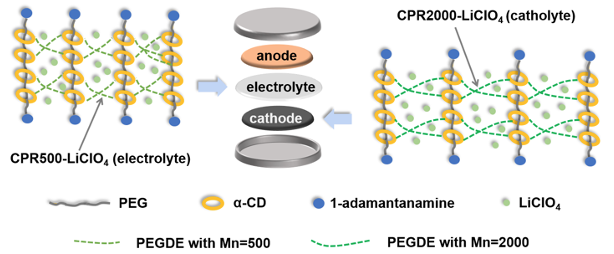Polyrotaxane-based networks as electrolytes and catholytes for all solid-state lithium batteries
Shanshan Yan, He Jia, Jean-François Gohy*
Institute of Condensed Matter and Nanosciences, Université catholique de Louvain
All solid-state lithium batteries are becoming increasingly noticeable in recent years due to their excellent properties such as high energy density and high safety1-2. Selecting the suitable polymer materials used as solid polymer electrolytes (SPEs) and the catholytes is crucial for improving the electrochemical performance of all solid-state lithium batteries3-4. Here, we are aiming to design polyrotaxane-based networks with different length of crosslinkers, which can be used for SPE and catholyte. Shorter crosslinker chains will be used to bridge polyrotaxanes to provide suitable mechanical strength for SPE. While longer crosslinker chains will be used to connect polyrotaxanes to afford excellent binding properties for the catholyte.
Herein, two polyrotaxane-based networks, CPR500 and CPR2000, have been prepared, loaded with lithium salts and further used as SPEs and catholytes for all solid-state batteries. The networks were obtained from polyrotaxanes functionalized by poly(ethylene glycol) diglycidyl ether (Mn=500 and 2000). The polyrotaxanes were composed of many macrocycles (α-cyclodextrins, α-CD) threaded onto a linear poly(ethylene glycol) chain (PEG) end-capped at both ends with bulky stoppers. The CPR500-LiClO4 SPE shows a high ionic conductivity of 7.25×10−4 S cm−1 and a wide electrochemical stability window from 1.6 to 4.0 V at 60℃. When CPR2000-LiClO4 is used as catholyte in LiFeO4 cathode (LFP2000) and CPR500-LiClO4 is employed as SPE, the LFP2000||CPR500-LiClO4||Li cell can achieve a high initial capacity of 167.8 mAh g−1 at 0.1 C (60℃).

- X Yang, K.R Adair, X Gao, X Sun, Energy Environ. Sci. 2021,14, 643-671.
- M. Arrese-Igor, M. Martinez-Ibañez, E. Pavlenko, M. Forsyth, H. Zhu, M. Armand, F. Aguesse, and P. López-Aranguren, ACS Energy Lett. 2022, 7, 1473−1480.
- Z. Li, J. Fu, S. Zheng, D. Li, and X. Guo, Small. 2022, 2200891.
- H. Al-Salih, M. S. E. Houache, E. A. Baranova, Y. Abu-Lebdeh, Adv. Energy Sustainability Res. 2022, 2200032.
